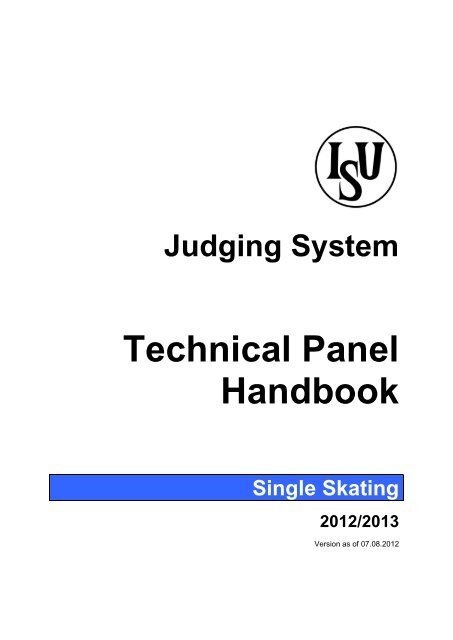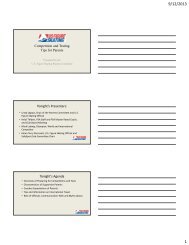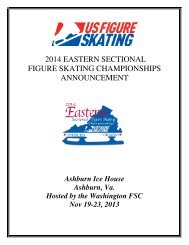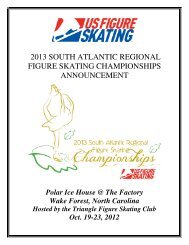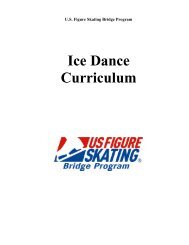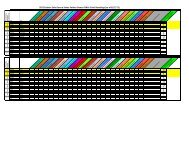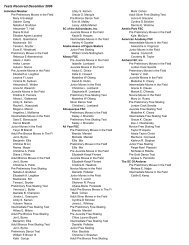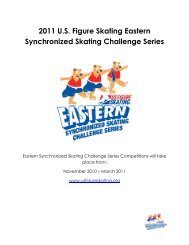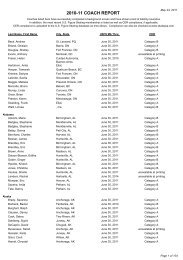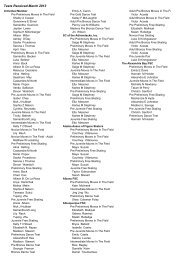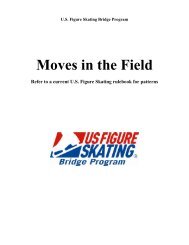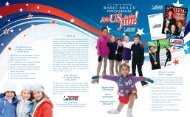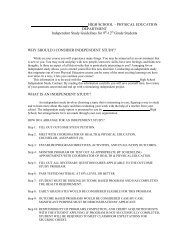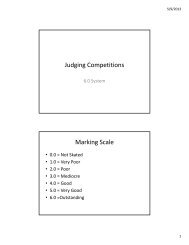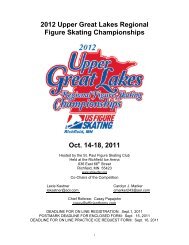Technical Panel Handbook - Singles - US Figure Skating
Technical Panel Handbook - Singles - US Figure Skating
Technical Panel Handbook - Singles - US Figure Skating
Create successful ePaper yourself
Turn your PDF publications into a flip-book with our unique Google optimized e-Paper software.
Judging System<br />
<strong>Technical</strong> <strong>Panel</strong><br />
<strong>Handbook</strong><br />
Single <strong>Skating</strong><br />
2012/2013<br />
Version as of 07.08.2012
Step Sequences<br />
Rules<br />
General All step se quences should be executed according to the cha racter of the musi c.<br />
Short stops in accordance with the m usic are permitted. Retrogressions are not<br />
prohibited.<br />
Turns and steps must be balanced in their distribution throughout the sequence.<br />
Short Program Short Program for Senior & Junior Men and for Senior & Junior Ladies must<br />
include one Step Sequence fully utilizing the ice surface.<br />
May include any unlisted jumps.<br />
Free <strong>Skating</strong> A well balanced Free <strong>Skating</strong> program must contain one Step Sequence fully<br />
utilizing the ice surface.<br />
The Competitors have complete freedom in selecting the ki nd of step sequ ence<br />
they intend to execute. Jumps can al so be included in the step sequ ence.<br />
Step sequences too short and barely visible cannot be considered as meeting the<br />
requirements of a step sequence.<br />
Level features<br />
1) Simple variety (Level 2), variety (Level 3), complexity (Level 4) of turns and steps throughout<br />
(compulsory)<br />
2) Rotations (turns, steps) in either direction (left and right) with full body rotation covering at least 1/3 of the<br />
pattern in total for each rotational direction<br />
3) Use of upper body movements for at least 1/3 of the pattern<br />
4) At least half a pattern on one foot only<br />
4) Two different combinations of 3 difficult turns (rockers, counters, brackets, twizzles, loops) quickly<br />
executed within the sequence<br />
Clarifications<br />
Pattern There is no longer a required pattern, but a step sequence must fully utilize the ice<br />
surface. It must be visible and identifiable and should be performed by using almost<br />
the full ice surface either in it length (e.g. straight line, serpentine or similar shape) or<br />
its width (e.g. circle, oval or similar shape) or both (combination of such shapes).<br />
Failure to achieve the above description will result in no value.<br />
In features 2 and 3 “pattern” means the pattern actually executed by the skater.<br />
Beginning and End<br />
of the pattern<br />
Definition of Turns<br />
and Steps<br />
This is when a skater actually starts or concludes the sequence.<br />
Different types of Turns: three turns, twizzles, brackets, loops, counters, rockers.<br />
Different types of Steps: toe steps, chasses, mohawks, choctaws. change of edge,<br />
cross rolls.<br />
Turns must be executed on one foot.<br />
Steps must be executed on one foot whenever possible.<br />
If a turn is “jumped ”, it is not counted as performed.<br />
Simple Variety Must include at least 7 turns and 4 steps, none of the types can be counted more<br />
than twice.<br />
Variety Must include at least 9 turns and 4 steps, none of the types can be counted more<br />
than twice.<br />
1
Complexity Must include at least 5 different types of turns and 3 types of steps all executed<br />
at least once in both directions. “Both directions” refers to rotational direction.<br />
<strong>Skating</strong> forward and skating backward is not a change of rotational direction.<br />
No simple variety,<br />
only simple variety,<br />
only variety<br />
If a skater does not perform a simple variety of steps and turns, the Level cannot be<br />
higher than 1. If a skater performs only simple variety of steps and turns, the Level<br />
cannot be higher than 2. If a skater performs only variety (but not complexity) of<br />
steps and turns, the Level cannot be higher than 3.<br />
Distribution Turns and/or Steps must be distributed throughout the sequence.<br />
There should be no long sections without Turns or Steps.<br />
If this requirement is not fulfilled, the Level cannot be higher than 1.<br />
Rotations in either<br />
direction<br />
Use of upper body<br />
movement<br />
Two combinations of<br />
difficult turns<br />
What makes the<br />
combinations same<br />
or different<br />
Jumps with more<br />
than half a revolution<br />
executed in the step<br />
sequence<br />
This feature means that a skater rotates continuously in one direction for at least 1/3<br />
of the sequence and then continuously for at least 1/3 of the sequence in the<br />
opposite direction or over the length of the step sequence the skater is performing<br />
turns for at least 1/3 of the sequence in total (not continuous) in one rotational<br />
direction and at least 1/3 of the sequence in total (not continuous) in the opposite<br />
direction.<br />
“Full body rotation” means one complete rotation. The skater should not just turn half<br />
a rev. back and forth.<br />
Use of upper body movements means the visible use for a combined total of at<br />
least 1/3 of the pattern of the step sequence any movements of the arms, and/or<br />
head and/or torso that have an effect on the balance of the main body core.<br />
Having an effect on the balance of main body core can also be understood as having<br />
an effect on the balance of the body as a whole and influencing the balance on the<br />
blade.<br />
Difficult turns are rockers, counters, brackets, twizzles, loops. In the combinations:<br />
- three turns are not allowed (not difficult turns);<br />
- changes of edges are not allowed (listed as steps);<br />
- a jump/hop is not allowed (not a turn);<br />
- changes of feet are not allowed;<br />
- at least one turn in the combination must be of a different type than the others.<br />
The exit edge of a turn is the entry edge of the next turn.<br />
The combination must be executed quickly which means that the turns are<br />
performed maintaining a consistent rhythm (tempo of movement) throughout the<br />
combination.<br />
Two combinations of difficult turns are considered to be the same if they consist of<br />
the same turns done in the same order and on the same edges and the same foot.<br />
Unlisted jumps, independent of their number of revolutions can be included in the<br />
step sequence without a deduction or any other consequence.<br />
Listed jumps with more than half revolution will be ignored in SP as an element, but<br />
will force the Judges to reduce GOE by 1 grade for “Listed jumps with more than ½<br />
rev. included”. Listed jumps can be included in the step sequence of the FS, will be<br />
identified and will occupy jumping boxes.<br />
In any case these jumps do not influence the determination of Level of difficulty of<br />
the Step sequence.<br />
2
Choreographic Sequences<br />
Rules<br />
Free <strong>Skating</strong> The choreographic sequence consist of any kind of movements such as<br />
steps, turns, spirals, ar abesques, spread eagles, Ina Bauers, hydroblading,<br />
transitional (unlisted) jumps, spinning mo vements etc. A Choreogra phic<br />
Sequence for Ladies must include at lea st one spiral (n ot a kick) o f any<br />
length. The Sequence commences with the first move and is concluded with<br />
the last move of the skater. The pattern is not restricted, but the Sequence<br />
must fully utilize the ice surface. If this req uirement is not fulfille d, the<br />
Sequence will have no value. The Choreographic Sequence is inclu ded in<br />
Free <strong>Skating</strong> and has to be performed afte r the Step Sequence. The<br />
Choreographic Sequence has a base value and will be evaluated by th e<br />
judges in GOE only.<br />
How to call the<br />
Choreographic<br />
Sequence<br />
Clarifications<br />
The call should be “Choreo Sequence confirmed” (if the Sequence will be counted)<br />
or “Choreo Sequence no value” in the opposite case.<br />
Pattern There is no required pattern but a Choreographic Sequence must fully utilize the ice<br />
surface. It must be visible and identifiable and should be performed by using almost<br />
the full ice surface either in it length (e.g. straight line, serpentine or similar shape) or<br />
its width (e.g. circle, oval or similar shape) or both (combination of such shapes).<br />
Failure to achieve the above description will result in no value.<br />
What does it mean,<br />
“not a kick”?<br />
This means that the free leg in the spiral position must be fixed for at least a<br />
moment. A kick is when the free leg goes up and down without any stop or fixed<br />
position in a spiral.<br />
Definition A Spiral is a position with one blade on the ice and the free leg (including knee and<br />
foot) higher than the hip level. Spiral positions must be on edge.<br />
No spiral position Choreographic Sequence will have no value.<br />
Listed jumps Listed jumps can be included in the Choreographic Sequence, will be identified and<br />
occupy jumping boxes.<br />
Order of Step<br />
Sequence and<br />
Choreographic<br />
Sequence<br />
In Senior Single Free <strong>Skating</strong> the <strong>Technical</strong> <strong>Panel</strong> will first identify the Step<br />
Sequence and only after this sequence is performed will look for and identify the<br />
Choreographic Sequence. Any movements performed prior to the Step Sequence<br />
are considered as Transitions.
Spins<br />
Rules<br />
General A Spin that has no basic position with 2 revolutions will receive no Level and<br />
no value, ho wever a spin with less th an three rotations is considered as a<br />
skating movement and not a spin.<br />
The minimum number of revolutions required in a position is two (2 ) without<br />
interruption. In case this requirement is not fulfilled, the position is not counted.<br />
Variations of positions of the head, arms or free leg, as well as fluctuations of<br />
speed are permitted.<br />
Positions: There are 3 basic positions: camel (free leg backwards with the knee<br />
higher than the hip level, however La yback, Biellmann and similar variations<br />
are still considered as upright spins), sit (the upper part of the skating le g at<br />
least parallel to the ice), uprig ht (any positio n with skating le g extended o r<br />
slightly bent which is not a camel position).<br />
Any position which is not basic is a non-basic position.<br />
Layback Spin is an up right spin in which head and should ers are le aning<br />
backwards with the ba ck arched. T he position of the free le g is option al.<br />
Sideways Leaning Spin is an up right spin in which head and shoulders are<br />
leaning sideways and the upper body is arched. The position of the free leg is<br />
optional.<br />
In any spin change of edge can be counted only if done in a basic position.<br />
The change of foot in any spin must be preceded and followe d by a spin<br />
position with at least three (3) revolutions.<br />
If the skate r falls wh en entering a spin, a spi n or a spinni ng movement is<br />
allowed immediately after this fall (f or filling time purpose) with this<br />
spin/movement not being counted as an element.<br />
If the spinning centres (before and after the ch ange of foot) are t oo far apart<br />
and the criteria of “two spi ns” is fulfilled (there is a curve of exit a fter the first<br />
part and the curve of entry into the second part), only the p art before the<br />
change of foot will be called and considered for Levels features.<br />
Spin combinations: the number of revolutions in positions that are not basic is<br />
counted in the total number of revolutions; such positions can be considered as<br />
difficult variations in cases the d efinition of a difficult variation i s fulfilled, but<br />
going to one of these positions is not considered as a change of position which<br />
can only be from one basic position to another basic position.<br />
Spin in one position and Flying spin (which means a spin with a flying entrance<br />
and no change of foot and position): positions that are not ba sic are allowed,<br />
counted in the total number of revolutions required by the Rules, but are not<br />
valid for Level features.<br />
In spins in one position and flying spins the concluding upright position at the<br />
end of the spin is not considered to be another position independent of the<br />
number of revolutions, as long as the skater is executing only the final wind-up<br />
without any enhancements.<br />
When the spin is commenced with a jump, no previous rotation on the ice<br />
before the take-off is permitted and a step over must be considered by the<br />
<strong>Technical</strong> <strong>Panel</strong> in the Levels and by the Judges in the Grade of execution.<br />
Short Program The Short Program of the season 2012 – 2013 includes the following 3 spins:<br />
1) Flying spin:<br />
Seniors :Flying spin with landing position different than in the Spin in one<br />
Position;<br />
Juniors: Flying camel spin;<br />
1
Specific elements in Short Program:<br />
Ladies: layback/sideways<br />
leaning spin<br />
Men: spin in one position<br />
with change of foot<br />
Spin combination with<br />
change of foot<br />
2) Spin in one position<br />
Senior Men: Camel/Sit spin (position different from the landing position of<br />
the Flying spin) with only one change of foot;<br />
Junior Men: Sit spin with only one change of foot;<br />
Senior & Junior Ladies: Layback/sideways leaning spin;<br />
3) Spin combination with only one change of foot.<br />
The spins must have a required minimum number of revolutions: eight (8) for<br />
the flying spin and the layback spin, six (6) revolutions on each foot in the spin<br />
with a change of foot and the spin combination, the lack of which must be<br />
reflected by the Judges in their marking.<br />
In the spin combination the change of foot is required.<br />
Except flying spins, spins cannot be commenced with a jump.<br />
Any position is permitted, as long as the basic layback or sideways leaning<br />
position is maintained for eight (8) revolutions without rising to an upright<br />
position. The position of a “Biellmann Spin” can only be taken and considered<br />
as a feature to in crease the Level after having successfully rotated the se<br />
required 8 revolutions in the layback position (backwards and/or sideways).<br />
Senior & Junior: The spin must consist of only on e change of foot, which<br />
may be executed by a step or a jump.<br />
Senior: The skater must choose the camel or the sit position, but this position<br />
must be different from the landing position of the Flying spin.<br />
Junior: Only the prescribed sit or camel position is permitted.<br />
Senior & Junior:<br />
The spin must have at least 3 revolutions before and after the change of foot.<br />
There must be at least 2 revolutions in the chosen (for Seniors) and in th e<br />
prescribed (for Juniors) basic position on each foot.<br />
If these requirements as stated above are not fulfilled, the spi n will have no<br />
value.<br />
The spin combination with change of foot must include only one change of<br />
foot and at least two basic positions with 2 revolutions in each of these<br />
positions. If these requirements are not fulfilled, the spin will have no value. If<br />
there are less than three basic positions with 2 revolutions in each, this will<br />
be reflected in the Level of the spin. The change of foot may be executed by<br />
a step or a jump.<br />
The change of foot and the change of position may be made either at the<br />
same time or separately.<br />
Flying spin Senior: Any type of flying spin is permitted with landing position different than<br />
in the Spin in one position. The landing position may be different from the<br />
flying position.<br />
Junior: Only the prescribed "Flying" position or its variation is permitted. The<br />
landing position must be the same as the flying position. In the flying sit spin<br />
changing foot on landing is permitted.<br />
Senior & Junior: No previous rotation on the ice before the take-off is<br />
permitted. The flying position must be attained in the air. The required<br />
revolutions can be executed in any variation of the landing position.<br />
Flying spin and the spin<br />
in one position<br />
Free <strong>Skating</strong><br />
If in Senior Men the landing position of the Flying spin is the same that in the<br />
Spin in one position, the last performed of these two spins will not be counted,<br />
but will occupy a spin box.<br />
A well bal anced Free <strong>Skating</strong> prog ram for Men and Ladies (Senior and<br />
Junior) must contain maximum of 3 spins, one of which must be a spin<br />
combination, one a flying spin or a spin with flying entrance and one a spin<br />
with only one position.<br />
All Spins must be of a different character. Any Spin with the same character<br />
(abbreviation) as the one executed before will be deleted by computer (but will<br />
occupy a spinning box).<br />
2
If no one of the performed spins has a flying entrance, or if no one is a spin in<br />
one position, or no one is a spin combination, the third executed spin will be<br />
automatically deleted by the computer.<br />
The spins must have a required minimum number of revolutions: six (6) for the<br />
flying spin a nd the spin with only on e position and ten (10) for the spin<br />
combination, the lack of which must be reflected by Judges in their marking.<br />
These minimum number of required revolutions must be counted from the<br />
entry of the spin until its e xit (except final wind-up in Spins in one position and<br />
Flying spins). In the spin combination and spin in on e position the change of<br />
foot is option al. The num ber of differen t positions in the spin combination is<br />
free.<br />
Level features<br />
1) Difficult variations (count as many times as performed with limitations specified below)<br />
2) Change of foot executed by jump<br />
3) Jump within a spin without changing feet<br />
4) Difficult variation of flying entrance/Landing on the same foot as take-off or changing foot on landing in a<br />
Flying Sit Spin<br />
5) Backward entrance<br />
6) Clear change of edge in sit (only from backward inside to forward outside), camel, Layback and Biellmann<br />
position<br />
7) All 3 basic positions on both feet<br />
8) Both directions immediately following each other in sit or camel spin<br />
9) Clear increase of speed in camel, sit, layback or Biellmann position<br />
10) At least 8 rev. without changes in position/variation, foot or edge (camel, layback, difficult variation of any<br />
basic position or for combinations only difficult variation of non-basic position)<br />
11) One clear change of layback position backwards-sideways or reverse, at least 3 rev. in each position<br />
(counts also if the Layback spin is a part of any other spin)<br />
12) Biellmann position after Layback spin (SP – after 8 revolutions in layback spin)<br />
Features 2 – 9, 11, 12 count only once per program (first time they are attempted). Feature 10 counts<br />
only once per program (first time it is successfully performed).<br />
Any category of difficult spin variation in a basic position counts only once per program (first time it<br />
is attempted). A difficult variation in a non-basic position counts once per program in spin<br />
combination only (first time it is attempted).<br />
In any spin with change of foot the maximum number of features attained on one foot is two (2).<br />
For Spin Combinations with change of foot all 3 basic positions are mandatory for Levels 2 – 4 in<br />
both Short Program and Free <strong>Skating</strong>.<br />
For Spins with change of foot at least one basic position on each foot is mandatory for Levels 2 – 4<br />
in Free <strong>Skating</strong>. In case this requirement is not fulfilled in Short Program, the spin will have no Level<br />
and consequently no value.<br />
Positions<br />
Spin with no change of<br />
position<br />
Clarifications<br />
A “spin with no change of position”, in which another basic position is<br />
executed with more than two (2) revolutions, does not fulfil the requirements<br />
of a spin with “no change of position” and will be identified as a “spin<br />
combination”. However, the concluding upright position at the end of the spin<br />
is not considered to be another position independent of the number of<br />
revolutions, as long as the skater is executing only the final wind-up without<br />
any enhancements.<br />
3
Spin combination with less<br />
than 2 revolutions in basic<br />
positions<br />
Spin combination with all<br />
three basic positions<br />
executed on both feet<br />
Clear change of position<br />
backwards-sideways or<br />
visa-versa (layback spin)<br />
Entrance of the spin<br />
Flying entrance<br />
Flying Spin: flying entry -<br />
position not attained in the<br />
air<br />
Flying entry: number of<br />
revolutions in non-basic<br />
position<br />
In Short Program a spin combination executed with only 1 basic position<br />
with not less than 2 revolutions and in all other positions less than 2<br />
revolutions will receive no Level.<br />
In Free <strong>Skating</strong> a clear visible attempt of a spin combination which results in<br />
a spin with only 1 basic position with not less than 2 revolutions will be called<br />
by the <strong>Technical</strong> <strong>Panel</strong> as a spin combination no value.<br />
In the spin combination, in order to be counted as a Level feature, all three<br />
basic positions must be executed on both feet.<br />
The feature will be awarded only if this change is done while maintaining the<br />
layback or sideways leaning position.<br />
Deathdrop, butterfly, Toe Arabian or any variation of another flying entrance<br />
(except the regular flying camel) count as a feature only once per program in<br />
the first spin they are attempted.<br />
In Free <strong>Skating</strong> normal flying camel e ntry does n ot block a p ossibility of<br />
counting a difficult flying entry as a feature.<br />
Flying entry is part of the character of the spin and is considered as an<br />
additional feature except in the case of a regular flying camel.<br />
If an obvious “step over” (instead of a jump) is performed or the skater does<br />
not attain the position in the air, thi s entrance cannot be con sidered as a<br />
feature and in the Short Program the Level cannot be higher than level 1. In<br />
Free <strong>Skating</strong> however just the corresponding feature will not be counted,<br />
but the other features can still be applied to reach a higher Level.<br />
The feature for the flying entry can be granted only if the basic position is<br />
reached within the first two (2) revolutions after the landing and this basic<br />
position is held for at least 2 revolutions .<br />
Flying Spin Short Program If the basic landing position of the Flying Spin in the Short Program is not<br />
reached within the first 2 revolutions after the landing and this basic position<br />
is not held for at least 2 revolutions, the Level cannot be higher than 1.<br />
Flying Sit Spin: landing on<br />
the same foot or changing<br />
foot on landing<br />
In a flying sit spin landing on the same foot as ta ke-off or changing foot on<br />
landing is counted as a feature only when the sit position is attained in the<br />
air.<br />
Backward entrance A backward entrance can be done, but is not limited to a forward inside three<br />
turn into the spin. In order to be counted as a feature backward entrance<br />
requires the first 2 revolutions on a backward outside edge in any position.<br />
Variations<br />
Simple variation A simple variation of position is a movement of a body part, leg, arm, hand<br />
or head, which does not have an effect on the balance of the main body<br />
core. A simple variation does not increase the Level.<br />
Difficult variation A difficult variation is a movement of a body part/leg/arm/hand/head, which<br />
requires more physical strength or flexibility and has an effect on the balance<br />
of the main body core. Only these variations can increase the Level.<br />
Categories of difficult<br />
variations<br />
There are 11 categories of difficult variations:<br />
For CAMEL POSITION there are 3 categories based on direction of the belly<br />
button:<br />
- (CF) Camel Forward: with belly button facing forward<br />
- (CS) Camel Sideways: with belly button facing sideways<br />
- (CU) Camel Upward: with belly button facing upward<br />
4
Crossfoot spin<br />
For SIT POSITION there are 3 categories based on position of free leg:<br />
- (SF) Sit Forward: with leg forward<br />
- (SS) Sit Sideways: with leg sideways<br />
- (SB) Sit Behind : with the leg behind<br />
For UPRIGHT POSITION there are 3 categories based on position of torso:<br />
- (UF) Upright Forward: with torso leaning forward<br />
- (<strong>US</strong>) Upright Straight or Sideways: with torso straight up or sideways<br />
- (UB) Upright Biellmann: in Biellmann position<br />
For LAYBACK POSITION there is 1 category<br />
- (UL) Upright Layback<br />
For NON-BASIC POSITIONS there is 1 category (NBP)<br />
A Crossfoot Spin must be executed on both feet with equal weight<br />
distribution. It is considered as a difficult variation of upright position (<strong>US</strong>)<br />
and will receive, if correctly executed, a feature. It is not required to stay on<br />
one foot for three revolutions before the cross.<br />
Biellmann position Biellmann position is a difficult variation of an upright position (UB) when the<br />
skater’s free leg is pulled from behind to a position higher than and towards<br />
the top of the head, close to the spinning axis of the skater. Like other<br />
categories of difficult spin variations, Biellmann position counts once per<br />
program (Short or Free) – first time it’s attempted.<br />
Windmill Windmill (Illusion) is considered as a difficult variation of non-basic position<br />
(NBP). This must be done at least 3 times in a row to be counted as a Level<br />
feature.<br />
Jump on the same foot<br />
within a Spin<br />
In any spin a clear jump started and landed on the same foot will be counted<br />
as a feature only if the skater has executed at least 2 revolutions in a basic<br />
position before and after the jump. The skater must reach the basic position<br />
within the first 2 revolutions after the landing.<br />
This jump can be performed even before the required minimum number of<br />
revolutions in a spin in order to be considered as a feature in both Short<br />
Program and Free <strong>Skating</strong>.<br />
Increase of speed For camel, sit, layback or Biellmann positions, once the position has been<br />
established, a clear increase of speed will be considered as a Level feature.<br />
Increase of speed counts only in a basic position or while going within a<br />
basic position into its variation. It is not valid as a feature if the increase of<br />
speed happens while going from one basic position to another basic<br />
position.<br />
Repetitions Any category of difficult spin variation in a basic position counts only once<br />
per program (first time it is attempted). A difficult variation in a non-basic<br />
position counts once per program in spin combination only (first time it is<br />
attempted).<br />
Features in repeated<br />
variations<br />
For Short Program and Free <strong>Skating</strong> once a difficult spin variation has<br />
been attempted and a difficult variation of the same category is executed,<br />
the variation cannot be counted, but any additional feature in this difficult<br />
variation can still be counted.<br />
What is an attempt? A difficult variation is considered as attempted when this variation is clearly<br />
visible, independent of the fact this variation was counted or not.<br />
Similar variations in basic<br />
and in non-basic positions<br />
If a difficult variation in a non-basic position of a sp in combination is quite<br />
similar to one of the alre ady executed difficult variation in a basi c position,<br />
the last performed of these two vari ations will not be counted as a Level<br />
feature.<br />
5
Edges and directions<br />
Clear change of edge<br />
A clear change of e dge can only be counted as a featu re in Sit from<br />
backward inside to forwa rd outside edge, Camel, Layback and Biellmann<br />
position. Any other attempt of a change of edge will be ignored, not blocking<br />
the possibility to credit it elsewhere.<br />
A clear change of edge can only be counted as a feature, if there are at least<br />
2 continuous revolutions on one edge followed by at lea st 2 continuous<br />
revolutions on the oth er edge in the same position (sit, camel, Layback or<br />
Biellmann). A change of edge within a n upright or non-basic position does<br />
not count as a feature.<br />
The change of edge counts as a feature that can increase the Level only<br />
once in a spin of the Sh ort Program and once in a spin of F ree <strong>Skating</strong><br />
Program.<br />
Spinning in both directions Spinning in both directions (clockwise & counter clockwise or visa-versa) in<br />
sit or camel position or i n a com bination of the two immedi ately following<br />
each other can be counted as a feature. A minimum of 3 revolutions in each<br />
direction is required. A spin executed in both directions (clockwise & counter<br />
clockwise) is considered as one spin.<br />
Number of Revolutions<br />
8 revolutions At least 8 re volutions without changes in po sition/variation, foot or edg e<br />
count as a feature only once per program, the first time when this feature is<br />
successfully performed in:<br />
1) camel, layback, difficult variation of any basic position – for all spins;<br />
2) difficult variation of non-basic position – for combinations only.<br />
Change of foot<br />
Change of foot<br />
(spin in one position and<br />
spin combination)<br />
Staying on the same foot<br />
To be considered, a change of foot in a spin requires at least three (3)<br />
revolutions before and after the change (these revolutions can be in any<br />
positions, including non-basic positions). If there are not three (3) revolution<br />
before or after the change, this results in the following:<br />
Short Program - the spin is not fulfilling the requirements and no Level and<br />
value will be given;<br />
Free <strong>Skating</strong> - the short part of the spin (before or after the change of foot)<br />
will not be called and will not be valid for Level features; the element<br />
becomes a spin in one position with no change of foot or a spin combination<br />
with no change of foot.<br />
A change of foot in a spin means spinning on each foot. Any spin in which<br />
the skater remains spinning on the same foot is not considered as a change<br />
of foot spin.<br />
Simple change of foot A simple change of foot, e.g. a step or a small hop does not require<br />
significant strength and skill and does not increase the Level.<br />
Change of foot executed by<br />
jump<br />
Toe Arabian as change of<br />
foot<br />
Change of foot executed by jump requires significant strength and skill.<br />
There must be a clear jump executed from a basic into the same or another<br />
basic position.<br />
Such change of foot can be counted as a feature only if the skater has<br />
executed at least 2 revolutions in a basic position before and after the jump.<br />
The skater must reach the basic position within the first 2 revolutions after<br />
the landing.<br />
This change of foot is allowed, will be considered as a change of foot<br />
executed by jump and will count as a feature only in Free <strong>Skating</strong>. If<br />
performed in Short Program, such change of foot will be considered as an<br />
error, will not count as a feature and the GOE will be reduced according to<br />
the ISU guidelines for touching the ice with the free foot.<br />
6
Spin with a second change<br />
of foot<br />
Spinning centres too far<br />
apart (spin in one position<br />
and spin combination)<br />
Number of features on one<br />
foot for spins with a change<br />
of foot<br />
Spin in one position with<br />
change of foot or spin<br />
combination: less than 2<br />
revolutions in a basic<br />
position on one foot<br />
A second change of foot (if attempted) in a spin with change of foot is not<br />
allowed in Short Program (wrong element) and does not count as a feature<br />
for a higher Level in Free <strong>Skating</strong>.<br />
If in a spin with change of foot there is a curve of exit after the first part and<br />
a curve of entry into the second part, the consequences are as follows:<br />
in Short Program - the spin is not fulfilling the requirements and no value<br />
will be given;<br />
in Free <strong>Skating</strong> - the second part of the spin will be ignored and the element<br />
becomes a spin in one position with no change of foot or a spin combination<br />
with no change of foot.<br />
If there is only a curve of exit after the first part or the curve of entry into the<br />
second part, this will result in GOE reduction for “Change of foot poorly<br />
executed”.<br />
The maximum number of features that a skater can get on one foot is 2.<br />
The features for backward or flying entry will be counted in the quota of the<br />
foot before the change.<br />
The features “Change of foot executed by jump”,” Spinning in both<br />
directions” and “All 3 basic positions on both feet” will be counted in the<br />
quota of the foot after the change.<br />
The feature for a crossfoot spin will be counted on the foot on which the<br />
cross position was started.<br />
Short Program: If there are 2 rev. on one foot in a basic position, but less<br />
than 2 rev. in a basic position on the other foot, the Spin will have no Level<br />
and consequently no value.<br />
Free <strong>Skating</strong>: If a spin has no basic position on one foot, the Level cannot<br />
be higher than 1.<br />
7
CF<br />
CAMEL FORWARD<br />
CS<br />
CAMEL SIDEWAYS<br />
CU<br />
CAMEL UPWARD<br />
SF<br />
SIT FORWARD<br />
SS<br />
SIT SIDEWAYS<br />
SB<br />
SIT BEHIND<br />
CAMEL POSITIONS<br />
SIT POSITIONS<br />
1
UF<br />
UPRIGHT FORWARD<br />
<strong>US</strong><br />
UPRIGHT STRAIGHT<br />
AND SIDEWAYS<br />
UB<br />
UPRIGHT<br />
BIELLMANN<br />
UL<br />
UPRIGHT LAYBACK<br />
NBP<br />
NON-BASIC<br />
POSITIONS<br />
UPRIGHT POSITIONS<br />
NON-BASIC POSITIONS<br />
2
Jump Elements<br />
Rules<br />
Solo jump<br />
Short Program Short Program of the season 2012 – 2013 must include 2 solo jumps:<br />
- double or triple Axel for Senior & Junior Men and for Senior Ladies, double<br />
Axel for Junior Ladies;<br />
- a jump immediately preceded by connecting steps and/or other comparable<br />
Free <strong>Skating</strong> movements:<br />
Senior Men - any triple or a quadruple jump;<br />
Senior Ladies - any triple jump;<br />
Junior Men and Ladies - double or triple Flip.<br />
For Senior Men when a quadruple jump is executed in a jump combination, a<br />
different quadruple jump can be included as a solo jump. For Senior & Junior<br />
Men and for Senior Ladies when the triple Axel is executed as an Axel jump, it<br />
cannot be repeated again as a solo jump or in the jump combination. Solo jumps<br />
must be different from the jumps included in the combination. A single spread<br />
eagle, spiral/Free <strong>Skating</strong> movement cannot be considered as meeting the<br />
requirements of connecting steps and/or other comparable Free <strong>Skating</strong><br />
movements the lack of which must be considered by the Judges in the GOE.<br />
Free <strong>Skating</strong> Jumping elements are individual jumps, jump combinations and jump sequences.<br />
A well balanced Free <strong>Skating</strong> program must contain 8 jumping elements for<br />
Senior & Junior Men and 7 jumping elements for Senior & Junior Ladies one<br />
of which must be (or must include) an Axel type jump.<br />
Individual jumps can contain any number of revolutions.<br />
A Double Axel cannot be included more than two (2 ) times in total in a Singl e’s<br />
Free Program (as a Solo Jump or a part of Combination / Sequence).<br />
Of all the triple and quadruple jumps only two (2) can be repeated and these<br />
repetitions must be in either a jump-combination or in a jump sequence. Triple<br />
and quadruple jumps with the same name will be considered as two different<br />
jumps. A repeated triple or quadruple jump, not included into a jump combination<br />
or jump sequence, will be considered as a part of a not successfully executed<br />
jump sequence and counted as a jump sequence with only one jump executed. If<br />
three (3) jump combinations or jump sequences (in total) have already been<br />
executed, the repeated solo jump will be treated as an additional element and<br />
therefore not considered (but this element will occupy a jump element box if there<br />
still is any left). No triple or quadruple jump can be attempted more than twice. If<br />
a third repeated jump is executed in a combination or sequence, the entire<br />
combination or sequence will be treated as an additional element and therefore<br />
not considered (but this element will occupy a jump element box if there still is<br />
any left).<br />
Jump combination<br />
General In a jump co mbination the landing foot of a jump is t he take off fo ot of the next<br />
jump. A three turn on one foot between the jumps without touching the ice with<br />
the free foot (or even with a touch, but no weight transfer) keeps the element in<br />
the frame of this definition allowing still to call it a combination (with an error).<br />
If the jump s are connected with a non-listed jump, the element is called as a<br />
jump sequence. However half-loo p (Euler) (landing backwards) when used in<br />
combinations/sequences is con sidered as a listed jump with the Value of a<br />
single Loop. When executed separately, half-loop stays as unlisted jump.<br />
If the first jump of a two-jump-combination fails to be successful and turns out as<br />
a “non-listed jump”, the unit will still be considered as a jump combination.<br />
Short Program Short Program must include a Jump Combination consisting of two jumps:<br />
Senior Men: double and triple or two triples or quadruple and a double or triple;<br />
1
Senior Ladies and Junior Men: double and triple or two triples;<br />
Junior Ladies: combination of two double jumps is also permitted.<br />
For Senior Men the jump combination may consist of the same jump or another<br />
double, triple or q uadruple jump. Fo r Senior Men when a q uadruple jump i s<br />
executed as a solo jump, a different quadruple jump can be included in the jump<br />
combination. For Seni or Ladies, Junior Men and Junior Ladies the j ump<br />
combination may consist of the same jump or another double or triple jump.<br />
However, for all categories the jumps included must be different than the solo<br />
jump.<br />
If the sa me jump is executed as a solo jump and as a part of the ju mp<br />
combination, the last performed of these jump elements will be not counted, but<br />
will occupy a jumping box (if this element is a jump combination, the whole jump<br />
combination will not be counted).<br />
Free <strong>Skating</strong> A jump combination may consist of the same or another single, double, triple or<br />
quadruple jump. There may be up to three jump combinations or jump<br />
sequences in the Free Program. One jump combination could consist of up to<br />
three (3) jumps, the other two up to two (2) jumps.<br />
Jump sequence<br />
Free <strong>Skating</strong> A jump sequence may consist of a ny number of jumps of any number of<br />
revolutions that may b e linked by n on-listed jumps and/or hops immediately<br />
following each other while maintaining the jump rhythm (knee); there can be no<br />
turns/steps (not even as an entry into a jump), crossovers or stroking during the<br />
sequence (Turns are three turns, twizzles, brackets, loops, counters, rockers.<br />
Steps are toe steps, chasses, mohawks, choctaws, curves with change of edge,<br />
cross-rolls).<br />
A jump sequ ence, consisting of only o ne listed jump together with other n onlisted<br />
jumps is not considered a jump sequence, but will count as a solo jump.<br />
Calling under-rotated or<br />
downgraded jumps<br />
Clarifications<br />
The <strong>Technical</strong> panel must call the attempted jump even if it is clear that it is<br />
under-rotated or will be downgraded. Both under-rotated and downgraded jumps<br />
will count as the intended jump in the application of Well Balanced Program<br />
regulations.<br />
The quarter and half mark of landing are the border lines to identify cheated<br />
jumps.<br />
The camera angle is important to consider when deciding upon a cheated jump<br />
particularly when the jump is at the opposite end of the rink than the camera.<br />
In all doubtful cases the <strong>Technical</strong> <strong>Panel</strong> should act to the benefit of the skater.<br />
Under-rotated jumps A jump will be considered as “Under-rotated” if it has missing rotation of more<br />
than ¼ revolution, but less than ½ revolution.<br />
An under-rotated jump will be indicated by the <strong>Technical</strong> <strong>Panel</strong> to the Judges and<br />
in the protocols with a “
Cheated take-off The same criteria is applied to jumps cheated at the take off. A clear forward<br />
(backward for Axel type jump) take off will be considered as a downgraded jump.<br />
The toe loop is the most commonly cheated on take-off jump.<br />
The <strong>Technical</strong> <strong>Panel</strong> may only watch the replay in regular speed to determine<br />
the cheat and downgrade on the take off (more often in combinations or<br />
sequences).<br />
Taking off from wrong<br />
edge (Flip/Lutz)<br />
Popped listed jumps<br />
In cases of not taking off from the clean correct edge the <strong>Technical</strong> <strong>Panel</strong> will<br />
indicate the error to the Judges using the sign “e” (edge).<br />
The <strong>Technical</strong> <strong>Panel</strong> may watch the replay in slow motion.<br />
Each Judge will then decide himself/herself on the severity of the error (major or<br />
minor error) and the corresponding GOE reduction.<br />
The attempt will count as one jump element. However, a small hop or jump with<br />
up to one-half revolution performed as a kind of “decoration” is not to be<br />
considered as a jump and will be marked within the component “Transitions”<br />
Non-listed jumps Jumps that are not listed in the SOV (e.g. Walley, split jump, Inside Axel with any<br />
number of revolutions taking off from the forward inside edge etc.) will not count<br />
as a jump element, but might be used as a special entrance to the jump to be<br />
considered in the mark for Transitions.<br />
A Toe Walley, however, will be called and counted as a Toe loop.<br />
Landing on another foot All jumps may be landed on either foot. The call goes for the jump, independent<br />
of the landing foot. Judges will evaluate the quality in their GOE.<br />
Landing on the other<br />
edge<br />
Spin exited immediately<br />
into a jump<br />
The call will not change if a jump is landed on the other edge. However Judges<br />
will reflect this in their GOE.<br />
If a skater performs a spin, immediately followed by a jump, the two elements<br />
are called separately. Credit is given to the difficult jump take off (GOE).<br />
Attempted Jump What is an attempt? In principle, a clear preparation for a take off for a jump,<br />
stepping to the entry edge or placing the toe pick into the ice and leaving the<br />
ice with or without a turn is considered an attempt of a jump, receives no value<br />
and blocks a box.<br />
In some cases, which need to be decided by the TP, the preparation for the<br />
take off without leaving the ice might be also called an attempt, e.g. a loop<br />
jump take off when the skater falls before leaving the ice, or a skater steps<br />
onto the forward take off edge of an Axel and pulls back the free leg and arms,<br />
starts the forward movement to jump into the air with the free leg and arms<br />
passing through forward but at the last moment does not leave the ice, etc.<br />
Fall/step out or touch<br />
down with free foot with<br />
weight transfer after a<br />
jump plus another jump<br />
Touch down with the<br />
free foot without weight<br />
transfer<br />
Short Program<br />
Element other than<br />
required<br />
If a skater falls or steps out on a jump and immediately after that executes<br />
another jump, the element does not remain a jump combination and will be<br />
called as follows:<br />
Short Program: “First Jump + Combo”; the continuation will be ignored by the<br />
<strong>Technical</strong> <strong>Panel</strong>.<br />
Free <strong>Skating</strong>: “First Jump + Sequence” (or “First Jump + Second Jump +<br />
Sequence” if the definition of a sequence is still fulfilled).<br />
The same applies to a jump combination of 3 jumps.<br />
In case of a touch down with the free foot without weight transfer and up to 2<br />
three turns or no turns between the jumps in a combination, the element<br />
remains a jump combination (however Judges will reduce the GOE because of<br />
error). In case of more than 2 three turns the call will be the jumps performed<br />
prior to three turns + combo in Short Program and + sequence in Free <strong>Skating</strong>.<br />
If a Junior skater performs a different jump than required, the element will<br />
receive no value, but will block the “jumping box”.<br />
3
Jump combination with<br />
3 jumps<br />
The entire combination will be deleted, but will block the “combination box”.<br />
Repetition of a jump A repeated jump of the same name with the same number of revolutions will<br />
be deleted, no value given, no GOE, but will occupy a jumping box; if executed<br />
in a jump combination, the jump combination in total will be deleted and no<br />
value given (but the corresponding box will be occupied).<br />
Only the jump combination can contain two same jumps.<br />
A repeated jump of the same name, but with different number of revolutions<br />
will receive credit.<br />
No second jump in a<br />
jump combination<br />
Free <strong>Skating</strong><br />
First repetition of a<br />
triple/quad jump<br />
Second/third repetition<br />
of a triple/quad jump<br />
Second jump combo<br />
with 3 jumps<br />
Jump sequence:<br />
reference to Rule<br />
Jump sequence: half<br />
revolution or more on<br />
the ice<br />
Axel type jump in a<br />
sequence<br />
Axel type jumps in a<br />
row<br />
If there is no second jump in a jump combination, the <strong>Technical</strong> <strong>Panel</strong><br />
identifies the intended combination during or after the program. If there is no<br />
clear way to identify the combination or the solo jump preceded by steps<br />
(steps or no steps in both cases), the <strong>Technical</strong> <strong>Panel</strong> will decide which one is<br />
the solo jump and which one is the combination in favour of the skater.<br />
First repetition of a triple or quad jump of the same name and the same<br />
number of revolutions without one of them being in a jump combination/<br />
sequence: the last executed jump will be identified as a “sequence” (with one<br />
jump only) and will block a “combo/sequence box”.<br />
Second/third repetition of a triple or quad jump of the same name and the<br />
same number of revolutions as a solo jump or in a jump combination/sequence<br />
will be treated as an additional element and therefore not considered (but will<br />
block the corresponding box).<br />
The entire combination will be deleted, but will block a box of the jump<br />
combination.<br />
From the moment the definition of a jump sequence is not fulfilled, the<br />
remainder of the jump sequence will be ignored and the element will be called<br />
the name of the first jump(s) plus the word “sequence”. The Judges’ GOE<br />
however will refer to the whole element performed.<br />
In cases of half a revolution (or more) on the ice from the completion of one<br />
jump before the commencement of the other jump, the element will not be<br />
considered as a jump sequence. The continuation will be ignored by the<br />
<strong>Technical</strong> <strong>Panel</strong>. The element will be called “first Jump + sequence”.<br />
If in a jump sequence an Axel type jump is the last performed jump, but the<br />
sequence has a mistake with the consequence that last performed jump will be<br />
ignored, the call will be “(first jump) + Axel no value + sequence”. With this call<br />
the Axel would count as a required element in Free <strong>Skating</strong>, but no points<br />
would be given.<br />
If an Axel type jum p immediately follows any oth er jump (without any ho ps,<br />
mazurkas, unlisted jumps), this will also be considered as a jump sequence.<br />
4
Max. Level<br />
SP<br />
Elements with no Level (no value) or maximum Level Basic/1/2/3 in SINGLES SP & FS<br />
Season 2012-2013<br />
(as of: August 7, 2012)<br />
Problem Max. Level<br />
FS<br />
All elements with Levels<br />
0 Wrong element N/A<br />
Basic+ded. Illegal elements/movements (if Basic Level requirements are<br />
fulfilled); TP is responsible for illegal elements deduction<br />
Step Sequences<br />
Basic+ded.<br />
0 Not satisfying minimal requirements specified in the TP <strong>Handbook</strong> 0<br />
1 No simple variety in steps & turns throughout the sequence 1<br />
2 Only simple variety in steps & turns throughout the sequence 2<br />
3 Only variety (no complexity) in steps & turns throughout the sequence 3<br />
1 No balance of steps & turns in their distribution through the sequence<br />
Choreographic Sequence<br />
1<br />
N/A Not satisfying minimal requirements specified in the TP <strong>Handbook</strong> No value<br />
N/A Min. requirements of one spiral position (not a kick) not fulfilled<br />
All Spins<br />
No value<br />
0 Does not have at least 2 continuous revolutions in a basic position<br />
Spins with change of foot<br />
0<br />
0 Less than 3 revolutions before/after the change No change of foot<br />
0 Spinning centers too far apart 2nd part ignored<br />
0 Second change of foot Any<br />
2 All features executed on one foot 2<br />
3 Only one feature executed on one of the feet<br />
Spin in one position with change of foot<br />
3<br />
0 No basic position on one foot for at least 2 revolutions<br />
Spin combination without change of foot<br />
1<br />
N/A Only one basic position with 2 revolutions 0<br />
N/A 2 basic positions with 2 revolutions<br />
Spin combination with change of foot<br />
Any<br />
0 1 basic position with 2 revolutions 0<br />
1 2 basic positions with 2 revolutions 1<br />
0 No basic position on 1 foot<br />
Layback<br />
1<br />
0 Less than 2 rev. + Biellmann Upright any Level<br />
No feature 2 or more, but less than 8 revolutions + Biellmann<br />
Flying Spin<br />
Layback any Level<br />
1 Step over No flying feature<br />
1 Position not attained in the air No flying feature<br />
1 Landing position not reached within the first 2 revs after landing No flying feature<br />
0 Wrong air position in the Flying Sit Spin (Juniors)<br />
Flying Combo Spin<br />
N/A<br />
Wrong el. Step over No flying feature<br />
Wrong el. Position not attained in the air No flying feature


